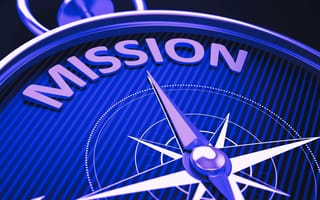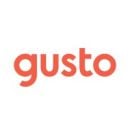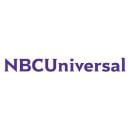Some skeptics are eager to criticize mission statements. They see them as generic and platitudinous, another startup box that founders need to check.
Turns out, though, a mission statement’s success depends on how it’s written.
What Is a Mission Statement?
In his influential 1998 research article, consultant and business professor Chris Bart found “a significant and positive correlation” between organizational performance and mission statements when managers were satisfied with those statements. He also found a correlation between performance and the process used to develop statements. Simply having a mission statement was a non-factor, but one created with real buy-in delivered the goods.
Mission Statement Examples
Later, we’ll explain what exactly makes a mission statement effective and explore tips for writing one. But first, here are some examples to fuel your inspiration.
Mission Statement Examples
- Apple: “To bring the best user experience to customers through innovative hardware, software and services.”
- Procter & Gamble: “To provide branded products and services of superior quality and value that improve the lives of the world’s consumers, now and for generations to come.”
- Reddit: “To bring community and belonging to everyone in the world.”
- Nike: “To bring inspiration and innovation to every athlete in the world. If you have a body, you are an athlete.”
Mission statement: “We bring together brands and their audience to make connections that matter.”
Mission statement: “Our mission is to reshape the credit industry and disrupt traditional processes. We believe in leading our business partners into the digital age to adapt to the tools and technologies that will allow them to remain at the forefront of their industries. Here at Bectran, we are committed to helping businesses leverage the power of SaaS solutions to save time and money and actualize their full growth potential through innovated, automated software.”
Mission statement: “We exist to transform the communications industry in a way that puts a smile on the faces of our clients, employees and investors.”
Mission statement: “At CSC, our mission, Thrive ’25, focuses on three core principles: Build—doing things that matter, Lead—setting the standard, and Transcend—going beyond limits. We are dedicated to empowering businesses through exceptional digital brand services and compliance solutions. By fostering a culture of innovation and excellence, we aim to inspire trust and success in every partnership, positively impacting our industry.”
Mission statement: “It is GitLab’s mission to make it so that everyone can contribute. When everyone can contribute, users become contributors and we greatly increase the rate of innovation.”
Mission statement: “We solve complex problems for countless strategic partners and thousands of employers. We help millions of individuals to thrive today, tomorrow and into retirement.”
Mission statement: “Tens of millions of Americans seek mental health care every day, but the vast majority never get the care they need. Headway is solving this, and we’re doing it all through software.”
Mission statement: “To be the most trusted and convenient destination for pet parents (and partners), everywhere.”
Mission statement: “To make homeownership less stressful and more accessible for American homeowners.”
Mission statement: “We strive to maximize business efficiency with an affordable and easy-to-use billing and invoicing service. We cater to time-strapped small businesses and freelancers who seek to grow their business and build their brand.”
Mission statement: “The Lowe’s strategy is rooted in serving our customers. We’re guided by our mission: Solving problems and fulfilling dreams for the home.”
Mission statement: “Our Mission is to deliver the best in health, wellness, beauty, and pet products to people all over the world.”
Mission statement: “We empower people with hearing loss to connect with their world through effortless technology and delightful care.”
Mission statement: “To help every team build, deploy and manage AI-powered software with full control and flexibility.”
Mission statement: “Our mission is to make authentication and authorization simple and secure for every developer.”
Mission statement: “Our mission is to bring new treatments to patients faster and more efficiently. We are a tech-driven, AI-native pharma company changing the way drug development is done.”
Mission statement: “Garner’s mission is to transform the healthcare economy, delivering high-quality and affordable care for all.”
Mission statement: “At Halter, we’re on a mission to enable farmers and graziers to run the most productive and sustainable operations.”
Mission Statement: “Our mission is to bring the best user experience to customers through innovative hardware, software and services.”
Mission statement: “Pie Insurance's mission is to enable small businesses to thrive by making commercial insurance affordable and as easy as pie.”
Mission statement: “Our mission is to improve health outcomes by eliminating confusion around benefits and coverage.”
Mission statement: “Our mission is to empower the people who run physical operations with tools to make their work safer, more productive and more profitable.”
Mission statement: “Our mission is to bring community and belonging to everyone in the world.”
Mission statement: “For over a decade, we’ve been building tech for food people, so restaurant owners can save money, staff members can save time, and diners can order better. Because when restaurants thrive, they can keep serving food that gives your community its unique flavor. We want to keep it that way.”
Mission statement: “To inspire and impact the world with vision, purpose, and style.”
Mission statement: “‘Experience Better’ is more than a tagline, it’s our mission.”
Mission statement: “Help families elevate the next generation through sports.”
Mission statement: “PatientPoint is on a mission to make every doctor-patient engagement better, and that goal is at the core of everything we do. We are the patient engagement platform for every point of care. Our digital solutions impact 750 million patient visits every year, helping drive better health outcomes that enable people to live longer, healthier lives.”
Mission statement: “We help people in crisis get life-changing aid.”
Mission statement: “Create a world where work empowers a better life.”
Mission statement: “We build lifelong financial relationships with the people in entertainment based on a deep understanding of how they live and work.”
Mission statement: “Alliant is unlike any other financial institution — a digital credit union that wows our members. We’re boldly disrupting banking norms to do good for our members, employees and communities.”
Mission statement: "To assemble a world-class combination of people, processes, and technology to drive the relentless pursuit of global trading opportunities."
Mission statement: “To be the premier content provider for television and digital platforms, spanning all television.”
Mission statement: “To empower the restaurant community to delight their guests, do what they love and thrive.”
Mission statement: “Our mission is to power the next generation of travel entrepreneurs, providing more access, better resources and a fresh perspective.”
Mission statement: “Renting should be rewarding.”
Mission statement: “At Supernova, our mission is to enable investors to achieve financial wellness.”
Mission statement: “We want to create a less lonely world by inspiring intimate, in-person connections.”
Mission statement: “Our mission is to make toolmaking ubiquitous.”
Mission statement: “To keep your passengers, pilots and planes seamlessly and continually connected worldwide.”
Mission statement: “We’re empowering everyone to create for the web — and leading impactful, fulfilling lives while we do it.”
Mission statement: “To be the trusted provider of the system that enables our customers to achieve and sustain business agility.”
Mission statement: “Stepful was founded to deliver affordable, online, AI-powered training that helps learners — especially from underserved communities — launch high-demand healthcare careers on their own terms. Our students are parents, career-changers, and first-generation college-goers who prove that, with the right tools and support, success is possible.”
Mission statement: “To bring inspiration and innovation to every athlete* in the world.
*If you have a body, you are an athlete.”
Mission statement: “Gradient AI is on a mission to increase precision and automation throughout the insurance industry.”
Mission statement: “To empower insurance to communicate simply, build trust and protect what people love.”
Mission statement: “We’re passionate about powering safe, informed, and efficient communities. Our mission is to innovate with heart by building intuitive COA software solutions that foster transparency, efficiency, and collaboration for everyone who calls an association home.”
Mission statement: “At Pokémon, our mission is to become an entertainment leader and bring the fun of Pokémon to people around the world!”
Mission statement: “To save lives and minimize loss by identifying active threats globally and facilitating timely communications when an emergency situation threatens personal safety and business continuity.”
Mission statement: “Our mission is to detect cancer early, when it can be cured. We are working to change the trajectory of cancer mortality and bring stakeholders together to adopt innovative, safe and effective technologies that can transform cancer screening.”
Mission statement: “We empower everyday people to move forward on the path to a better financial future.”
Mission statement: “We help people secure their future and protect the ones they love.”
Mission statement: “To help humanity thrive by enabling the world's teams to work together effortlessly.”
Mission statement: “Our mission is to build technology products that move the way people move.”
Mission statement: “We will provide branded products and services of superior quality and value that improve the lives of the world’s consumers, now and for generations to come. As a result, consumers will reward us with leadership sales, profit and value creation, allowing our people, our shareholders and the communities in which we live and work to prosper.”
Mission statement: “We create technology solutions seeking to revolutionize the experience of consumers seeking financial health and endeavors to ensure nobody gets locked out of the financial system.”
Mission statement: “We exist to advance the economic power of people living and working in the real world.”
Mission statement: “To unite everyday people to unlock their financial progress. By eliminating unnecessary fees and simplifying the credit building process, we’ve empowered millions of everyday people to take control of their finances.”
Mission statement: “Our mission is to provide small businesses with the best funding options for each and every project or capital need, with technology that makes business financing easy to understand and easy to access.”
Mission statement: “Our mission is to make the best care possible for all pets.”
Mission statement: “At Axle Health, our mission is to empower home health care providers with innovative technology that drives operational excellence.”
Mission statement: “Our mission is to design a more enlightened way of working. Dropbox helps people be organized, stay focused and get in sync with their teams.”
Mission statement: “At Inato, we’re on a mission to bring clinical research to each and every patient, regardless of who they are and where they live.”
Mission statement: “Always with you, building a more confident future. MetLife contributes to a more confident future as an employer, an investor and a provider of financial solutions and expertise. Our purpose is at the heart of our virtuous circle of delivering for our colleagues, our communities, our customers and our shareholders.”
Mission statement: “Let's Make Life Delicious. It’s our reason to exist. It reminds us, day in and out, why we’re here. Simply, we help feed the world — and we do it deliciously.”
Mission statement: “We’ve built the nation’s leading social care network with a clear focus on our mission — to connect people to the help they need with dignity and ease.”
Mission statement: “Restaurants sit at the heart of communities. It’s our mission to strengthen their roots, deepen their connections, and increase the positive impact they have on people and society.”
Mission statement: “Our mission is to help your people and your industrial assets become smarter and more visible.”
Mission statement: “To empower coaches and educators in their dedication to develop the leaders of tomorrow. Our vision is to strengthen developing programs through technology-driven, community-first solutions that support dedicated leaders and champion the next generation.”
Mission statement: “Making the world’s best workplaces safer and more sustainable.”
Mission statement: “Our purpose is to make renting work for all of us: to support every path, and simplify the way forward.”
How to Write a Mission Statement
When it comes time to draft your company’s mission statement, consider the following:
Tips for Writing a Mission Statement
- Make it simple, aspirational and memorable.
- Direct it toward stakeholders
- Don’t prioritize shareholders.
- Keep employees — current and future — top of mind.
- Avoid superlatives and saying you’re “the best” company.
- Leave room for the mission to evolve.
1. Make it Simple, Aspirational and Memorable
A successful mission statement has three important traits, according to Jeffrey Abrahams, author of 101 Mission Statements From Top Companies. They are simplicity, aspiration and memorability.
Simplicity
There’s no magic word count, but experts agree that concision is best. Abrahams recommends aiming for a single-sentence statement. “That has greater impact and can be communicated easily, both within the company and to the target audience,” he said.
Bart, meanwhile, recommends capping at around 70 words. And Inés Alegre, a professor at the business school of the University of Navarra who led a 2018 review of mission-statement research, told Built In that three sentences or so is appropriate.
Your precise mileage may vary, but the “KISS” recommendation put forward by Bart in his 1998 paper still seems appropriate: Keep it simple and straightforward.
Aspiration
It’s common to find an organization’s mission statement posted on an “About” page, but it doesn’t have to be merely descriptive; incorporate some ambition, Abrahams suggested. He invoked Microsoft’s statement: “Our mission is to empower every person and every organization on the planet to achieve more.”
Memorability
Action verbs, wariness of jargon and bizspeak — these are a CEO’s allies when drafting a statement. It should be organization-specific, too.
“If the mission statement could be used by a number of companies, especially competitors, it’s not going to be either memorable or serve the company very well,” said Abrahams. “You want it to be distinctive.”
2. Direct It Toward Stakeholders
“Missions describe why an organization exists, but in particular, they should describe the relationships that the organization wants to have with the stakeholders upon whom it depends for survival, growth and sustainability,” Bart said.
According to him, an effective mission statement should at least speak to two audiences: customers and employees. He cited Southwest Airlines as an illustrative example:
“The mission of Southwest Airlines is dedication to the highest quality of customer service delivered with a sense of warmth, friendliness, individual pride and company spirit.
To our employees: We are committed to provide our employees a stable work environment with equal opportunity for learning and personal growth. Creativity and innovation are encouraged for improving the effectiveness of Southwest Airlines. Above all, employees will be provided the same concern, respect and caring attitude within the organization that they are expected to share externally with every Southwest customer.”
In addition to customers and employees, a strong statement will also often address shareholders and the community at large, Bart said. Here’s one he helped draft for a casino resort that directly targets all four groups:
“Our mission is to provide every guest with a ‘blow away experience’ that is inspired by a celebration of the sea and the myth of a lost civilization. We accomplish this by bringing the myth of Atlantis to life by offering warm, positive, engaging service.
At Atlantis, we are a team of individuals who are passionate and committed in everything that we do. We continuously strive for perfection. We are proud to work at Atlantis because we are a caring and learning organization, which rewards accomplishment and promotes teamwork, respect and innovation.
At Atlantis, we are the pride of our community while providing enduring value for our shareholders. When Atlantis succeeds, we succeed as individuals, and we contribute to the success of the Bahamas.”
3. Avoid Prioritizing Shareholders
It may be more obvious today — after the rise of sustainable investing, office-perk culture that caters to employee happiness and the fact that we’re in the midst of a job seekers’ market — but the thrust of the mission can’t simply be shareholder yield.
Statements that center the returns of the investor class will align approximately zero employees to an organization’s mission. “Shareholder value was the typical mission in the nineties — not anymore,” said Alegre.
One possible symptom of such misalignment? Jargon creep. “When buzzwords and platitudes happen, they usually happen when the focus of the company moves from customer to shareholder,” wrote entrepreneur and Built In expert contributor Joe Procopio.
4. Don’t Use Superlatives
As mentioned, mission statements should have an air of the aspirational. But, especially in this era of superlative fatigue, beware of “the biggest,” “the boldest” and “the best.” They’ll inspire more shrugs than hearts, especially when unsupported.
“When a company says its mission statement is to be the best [category here] company in the world — the best steel company in the world or the best clothing company in the world, it’s too general,” said Abrahams. “It needs to be backed up by strongly worded core values, a vision, and guiding principles and beliefs.”
5. Use the Mission Statement as a Management Tool
Even though mission statements address multiple audiences, they shouldn’t pretend to think each audience is listening with equal attention.
“There’s a question of prioritization of stakeholders — is it the clients, employees, suppliers, investors? You probably cannot satisfy all at the same level,” said Alegre.
That begs a question: Should companies think of mission statements more as an internal compass for culture and strategy, or an external branding — or even recruiting — element? That is, are they management or marketing?
“My answer is yes,” said Abrahams.
Ideally, it can serve as both, experts told Built In, but it should be considered first and foremost a management tool. (Indeed, most research on the topic is published in management, not marketing, journals.) “My impression is that it’s much more useful as an internal alignment tool than external branding,” said Alegre.
Think of the statement primarily as something for employees, Bart said, a true north against which the workforce can always orient itself.
6. Reinforce the Mission Statement in All Your Communications
Once the statement is finalized, think of it as a muscle: Exercise it often to prevent it from losing definition. Reference the mission during onboardings, training, team meetings, board reviews of key projects and wherever else reinforcement makes sense. Post it on your website, of course, but also your wall. “I work in a business school where the first thing you see after the entrance is the mission,” Alegre said.
Mission statements are especially important during times of uncertainty, such as early in an organization’s life or during growth pushes, Alegre said. Still, lean on them in times of greater stability, too. That provides room for the mission to organically evolve.
Frequently Asked Questions
What makes a mission statement effective?
An effective mission statement is short, clear and memorable. It captures a company’s purpose, values and aspirations while speaking directly to key stakeholders — especially employees and customers. It avoids jargon, superlatives and shareholder-focused language.
How do you write a good mission statement for a company?
To write a strong mission statement, keep it simple, aspirational and specific to your organization. Use action-oriented language, prioritize stakeholders, avoid clichés like “the best,” and leave room for the mission to evolve as the company grows.
Why are mission statements important for businesses?
Mission statements help align employees, guide company culture and inform strategic decisions. Research shows that when managers are satisfied with their company’s mission statement — and involved in crafting it — organizational performance improves.










































































